EYE TRAINING FOR THE CURE OF FUNCTIONAL MYOPIA.*
By W. H. BATES, M. D., New York.
New York Medical Journal, May 18, 1912, pp. 1029–32.
*Read before the Medical Association of the Greater City of New York, January 15, 1912.
In functional myopia the eye is adjusted for near vision without permanent elongation of the optic axis, as is found in true myopia. The defective vision is usually improved by concave glasses. The diagnosis has been made with the aid of the ophthalmoscope. By the direct method the details of the fundus were seen momentarily with clearness by the normal eye. Many cases have been recognized by retinoscopy. The local and prolonged use of sulphate of atropine has not always relieved functional myopia.
Occurrence. Functional myopia occurs universally. Newborn children are afflicted. It was found in varying degrees in more than ten thousand school children, and was responsible for nearly all the eye pain, asthenopia, headaches, defective vision, irritability, not only of the children, but of the teachers as well. It was found frequently among farmers, day laborers, sailors, mechanics, and professional men and women. The oldest treated was aged seventy-six.
Most persons with normal eyes when they regard large objects at a distance are unconsciously functionally myopic. The eye is habitually focused for a near point, and the continuous muscular effort is often injurious. But when regarding small or large distant objects clearly or when reading the XX line of the Snellen test card at twenty feet, the normal eye was adjusted accurately for distant vision and was at rest. Simultaneous retinoscopy demonstrated the facts.
Children, when entering school, usually have normal vision. In a short time, a few weeks, they acquire functional myopia. The discomforts which school children suffer from functional myopia can be appreciated only by teachers and others who have had practical experience with these unfortunates.
In one class room of forty pupils, first year children, six to eight years old, the teacher noted that at the opening of school in the Fall, all the children could see the writing or letters on the blackboard; but, before school closed in the following Spring, all, without exception, complained that they could not see the writing or letters on the blackboard from their seats, when distant more than ten feet. This had been her experience each year for fifteen years. The eyes of her pupils were first examined in the Spring of 1903; result, all had difficulty in reading the Snellen test card. Thirty were relieved almost immediately, in less than five minutes, when their eyes were tested, by showing them with the aid of the same test card how to regard distant objects without an accommodative effort. Relapses were prevented, and the remaining ten defectives cured by the teacher by exercises in distant vision with the aid of the Snellen card. This teacher afterward used the card continuously for eight years, and stated that as a result no more children in her room acquired defective vision. Her success in relieving or preventing functional myopia was also achieved by more than fifty other teachers. Numerous other benefits were observed, less headache, fatigue, and irritability. The teachers themselves found relief from eyestrain by the use of the card. The exercises in distant vision required less than half a minute daily and were not objectionable in any way, to my knowledge. A Snellen test card was placed permanently in each class room where all the children could see it from their seats, with the directions: Read daily the smallest letters you can see with each eye at more than ten feet.
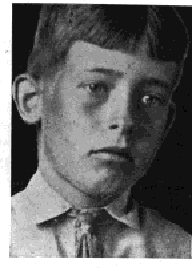
Fig. 1.—A boy with normal eyes reading the X line of the Snellen test card at ten feet. Note the expression of the eyes with the focus completely relaxed. |
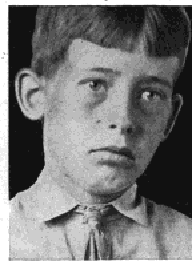
Fig. 2.—The same as Fig. 1, regarding a picture at twenty feet. Simultaneous retinoscopy indicated compound myopic astigatism. He was unconscrious of the fact that his eyes were focused for a near point. Note the manifestation of effort by staring. |
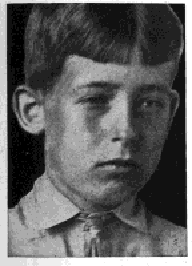
Fig. 3.—Functional myopia produced voluntarily by partly closing the eyelids and making an effort to read the Snellen test card at ten feet. |
Most persons with functional myopia were tinconscious of the effort made to see distant objects. (See Figs. 1, 2, 4, 5.) They were benefited after
they became conscious that an effort lowered the vision. (See Figs. 3, 6, 7.) One method: They were directed to regard the smallest letters they could see on the Snellen card at more than ten feet and to note their clearness. By partly closing their eyelids, by staring or otherwise making a voluntary strain, they observed that the letters became blurred. It was then suggested that they regard the card without effort. The alternate strain and relaxation were repeated until the patient was convinced that an effort to see distant objects lowered the acuity of vision; while, regarding the card without effort made the vision better. The exaggeration of the unconscious effort was usually followed by a greater relaxation of the effort to see distant objects. The simultaneous use of the retinoscope indicated improvement, less functional myopia, and the vision improved. A large amount of compound myopic astigmatism. 4.D.. has been observed with the retinoscope in a normal eye during the time the patient made an effort to read the Snellen card with the eyelids partly closed. With each suceeding effort the myopia became less until it disappeared, and the patient no longer produced myopia by partly closing the eyelids and making an effort to see the distant card.
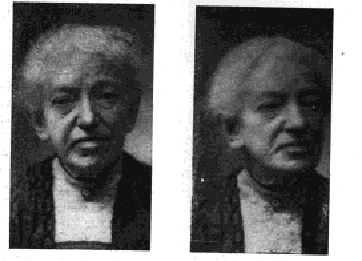 |
|
Fig. 4.—Regarding the Snellen test card at ten feet with normal vision. This patient had incipient cataract. When she made an effort, unsuccessfully to read at six inches, simultaneous retinoscopy indicated +2.00 D. S.. combined with +2.00 D. C., 18o°. |
Fig. 5.—Regarding a picture at twenty feet and making an effort to see it more clearly, simultaneous retinoscopy, compound myopic astigmatism. |
Patients with functional myopia were instructed in excentric fixation: When the normal eye read one letter of the line marked XX on the card at twenty feet, the eye was directed straight to the letter. When the eye was directed to a point less than six inches to one side of the letter it became indistinct. In fact, the area of maximum vision at twenty feet is less than one inch in diameter. Looking straight at a small letter, central fixation is necessarv for the best vision. Regarding an object with the eye directed to one side of it. excentric fixation, always lowers the vision. In functional myopia, excentric fixation was frequently found, either in one eye or both. Such cases were not benefited until after it was corrected. In order to teach the patient how to regard objects by central fixation he was first shown how to exaggerate it. For example. he regarded the large letter of the card with one eye, the other being covered. He was then directed to look at a point three feet to one side of the card and to note that the large letter now became less distinct. The fixation point was gradually brought nearer to the letter until he could recognize that an excentric fixation of only a few inches lowered the vision. The patient then tested the effect of excentric fixation on the clearness of the smallest letters he could see. This simple demonstration proved to the patient the necessity of central fixation in securing the best vision and was successful in relieving many cases promptly. The functional myopia was benefited.
CASE. A girl, aged fourteen years. right vision, fingers counted at four feet, excentric fixation of 45°, amblyopia ex anopsia, convergent squint, and functional myopia. The left eye was normal. She was treated in February, 1903. The excentric fixation was corrected in the right eye after she learned with the aid of the other and normal eye that perfect vision was only possible by central fixation. Eye training, with the aid of the Snellen card, was followed by daily improvement in the functional myopia until the vision became normal. She obtained binocular single vision and was cured in two weeks. The good result was permanent after eight years.
Twitching of the muscles of the eyelids occurred frequently in functional myopia. It was so pronounced in some cases that it was readily seen. In other cases it was felt by light pressure on the closed eyelids with the tip of the finger. After the patient was told of its presence and encouraged to rest the closed eyes until it had ceased, the vision improved. When the twitching returned the vision became less. After some days the twitching usually ceased and the vision remained good.
Near use of the eyes. By retinoscopy it was discovered that an effort to read by a dim light at thirteen inches or less benefited functional myopia. While the eye was reading without difficulty diamond type at thirteen inches the refraction by retinoscopy was corrected by a concave thirteen inch or 3.00 D. glass; but, when an effort was made, or the effort was unsuccessful in reading the type, simultaneous retinoscopy indicated that the focus was less and was corrected by concave 2.50 D., 2.00 D., 1.00D., or by a weak convex glass (usually at 180° only). In some cases of functional myopia one or more meridians became normal. When tested with the distant Snellen card immediately afterward. the vision was improved. Repeated efforts to read by a dim light, at thirteen inches or less, fine print, Jaeger No. 1, was a great benefit.
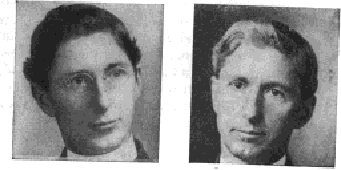 |
|
Fig. 6.—A man, aged thirty-six years, 1902, wearing glasses for the correction of functional myopia. Homatropirie did not relax the focus. Note the appearance of effort in his eyes. He was relieved in 1904 by exercises in distant vision and obtained normal sight without glasses. |
Fig. 7.—The same in 1909. No relapse. |
Mrs. X. visited the eye clinic of the Amity Dispensary one day last summer. Her object was to investigate the cause of myopia in school children. She was first shown the use of the retinoscope. A boy, aged ten years, was sent by a school inspector to obtain glasses. He had a vision of one fourth the normal. With a concave 2.00 D. S., his vision was normal. Mrs. X. used the retinoscope while the patient was trying to read the Snellen card, at ten feet, and found him myopic. The patient was urged to try to see better at the distance, to read the smaller letters of the test card, and he did make very evident efforts to see better by wrinkling the skin of the forehead, by partly closing the eyelids, by staring, and by looking sidewise at the card, excentric fixation. He became convinced that with all his efforts he not only did not improve his sight but he made it much worse. He was then told that he would see better if he looked at the card without making an effort. After a little encouragement he obtained normal vision. While he was reading the card with normal vision, Mrs. X. used the retinoscope, which now indicated no myopia. The time required to relieve this boy of functional mycpia was less than fifteen minutes. To prevent a relapse the patient was given a Snellen card with directions to read the small letters at more than ten feet with each eye daily. Mrs. X. observed other and similar cases relieved.
We had a talk, the substance of which was that I should cure functional myopia in school children after some well known and competent physicians had made the diagnosis. She emphasized the importance of this plan to test the facts I claimed.
Mrs. X. was wearing glasses, concave 1.00 D. nearly, with astigmatism, prescribed by a competent ophthalmologist who had used a cycloplegic to relax the accommodation. Her vision with the glasses was nearly normal. Without glasses her visin was about one third. She had myopia apparently with the retinoscope, but spasm of the accommodation or functional myopia by the direct method with the ophthalmoscope. She was told that a cure without concave or other glasses was possible.
“How long will it take?” she asked.
“About five minutes,” was my reply. She was asked to read the Snellen card at ten feet and to note her ability to see. Then she was directed to read it by making an effort and shown how to make an effort by partly closing the eyelids, by staring, etc., in short, to imitate the efforts of the children she saw treated. She was convinced that the effort materially lowered the vision. It was explained to her that her poor vision was caused by a continuous effort which was unconscious. The suggestion was then made that she read the letters on the distant card without trying so hard. The vision improved immediately and became normal in a short time. Her sight was now better without glasses than it had been before with glasses. She was quite excited over the prompt relief.
A number of physicians have visited the same clinic, diagnosticated functional myopia with the aid of the retinoscope, and observed its prompt relief by eye training with the aid of the Snellen card.
The maximum amount of functional myopia under atropine cured by eye training without glasses was 2.50 D.
CONCLUSIONS.
1. Functional myopia occurs frequently.
2. All normal eyes acquire functional myopia by improper efforts to see distant objects.
3. School teachers, physicians, and others have relieved functional myopia by eye training or education.
4. The Snellen test card is found to be the best distant object for training the eye for the cure of functional myopia.
938 ST. NICHOLAS AVENUE.




